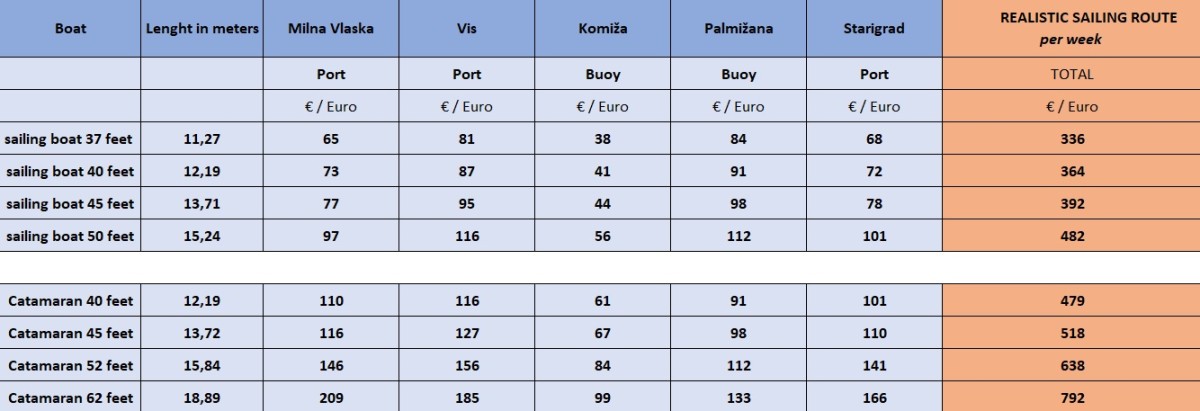We use cookies, along with some third-party sites (like Google, Facebook, etc.). By continuing to visit this site you agree to our use of cookies.


- Search Yachts
- Destinations
- Company
- Sailing info
- Blog
Need help? Contact us
To illustrate the cost of port fees in Croatia, we will take a typical HYPOTHETICAL sailing route in Split area. This, without a doubt, is the most expensive route you can take in one week, and we will take this route in a way that you dock every night, and in high season when the prices are the most expensive.
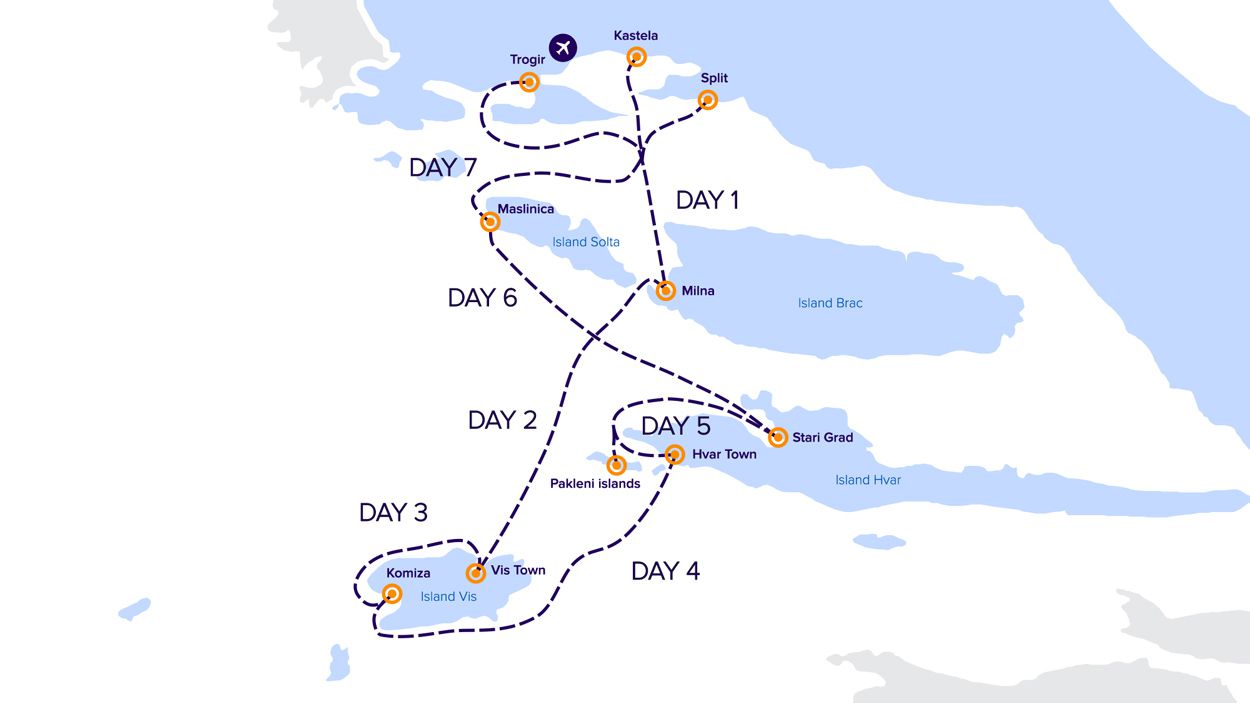
We will make few calculations for this route, with few different boats, so everybody could see the approximate costs depending on the type and size of their boat.
Of course, this route is just a HYPOTHETICAL example and in high season, it would be almost impossible to take this route in a way to you are docked every night.
Why almost impossible? Because, in high season the weather is, in general, very nice and there is no need to be docked every night. In addition, in order to get a place in all of these ports every night, you would have to arrive in the port no later than noon, or 1 PM. Alternatively, you would have to have a good local skipper who will make sure that you do get a place if you arrive later, through his personal acquaintances and arranged reservation fees for port people, and sometimes, even that’s not possible.
THE MOST EXPENSIVE HYPOTHETICAL SAILING ROUTE in CROATIA you could take sometime in the period from 1st July to 31st August would look like this:
THE REALISTIC SAILING ROUTE IN SPLIT AREA would be the same route as the most expensive one above, visiting the same destinations, in the same period from 1st July to 31st August, but, it is calculated more realistically with 3 nights docked, 2 on a buoy and one night on anchor.
The hypothetical most expensive route is calculated in a way that the boat is docked every night in high season. The realistic sailing route includes three nights docked, two on a buoy and one on an anchor. Prices show standard one-week sailing route.

PRICELISTS we used for every port you can find here:
Port fees in Croatia are quite expensive and they tend to be more expensive each year.
Who are you paying the port fees to? In one way or another, in the end, you are paying to Croatian Government. Even if it is some privately owned marina, they are actually paying large amounts for the concession of the port area to the government.
ACI marinas, the largest marina chain in the Med, is a company mostly owned by a Croatian government. Local town ports, although have separate management, are also under direct control of the state, therefore, the government.
Why are these port fees so expensive?
It is a very simple and a large income into pockets of everybody involved in that business, and people who want to sail have no other choice, but to use their 'services'. Especially when the weather is not so good. On one hand, you can be furious and feel ripped off by paying such high port fees, on the other hand, the demand for those port docks is so large, that we can almost say it actually needs to be reduced. Because it is killing the atmosphere. Too many boats all around you will not provide you with a feeling you yearn for when you are going sailing. The demand in July and August is extremely big. In addition, all these boats leave at least some sort of garbage and pollution, they don't sail without any consequences. Croatian people and government have no way to charge them for it. But, this is not the topic of this article.
Also, we must note that Croatian maritime infrastructure, in regard to these port facilities, is really high-end. It can be compared only to some high-end places in Italy. It is safe. It is convenient. Compared to Greece it is about 30 years in the future (concerning the money you pay too). But, try sailing in Greece around Cyclades area in August – strong winds, big waves and big distances between the islands will make your sailing so intensive and you will understand why is there such a big demand for sailing in Croatia.
It's also important to note here, that because of such high demand, so many new charter boats coming, in high season there is already a lack of safe anchorages, and because of this, Croatian authorities are forced to place mooring buoys in many bays. This is to avoid accidents on an anchor and to protect sea bottom.
So, let's conclude with - Concerning what Croatia as a sailing destination has to offer to sailors compared to other popular sailing destinations, and concerning also the demand for sailing in Croatia, prices of port fees might be a bit exaggerated, but not too much.
What's the price of port fees in Croatia?
As there is no unique pricelist for every port or marina in Croatia, it is really impossible to answer the question like 'What is the cost of port fees in Croatia?' in a simple and precise manner.
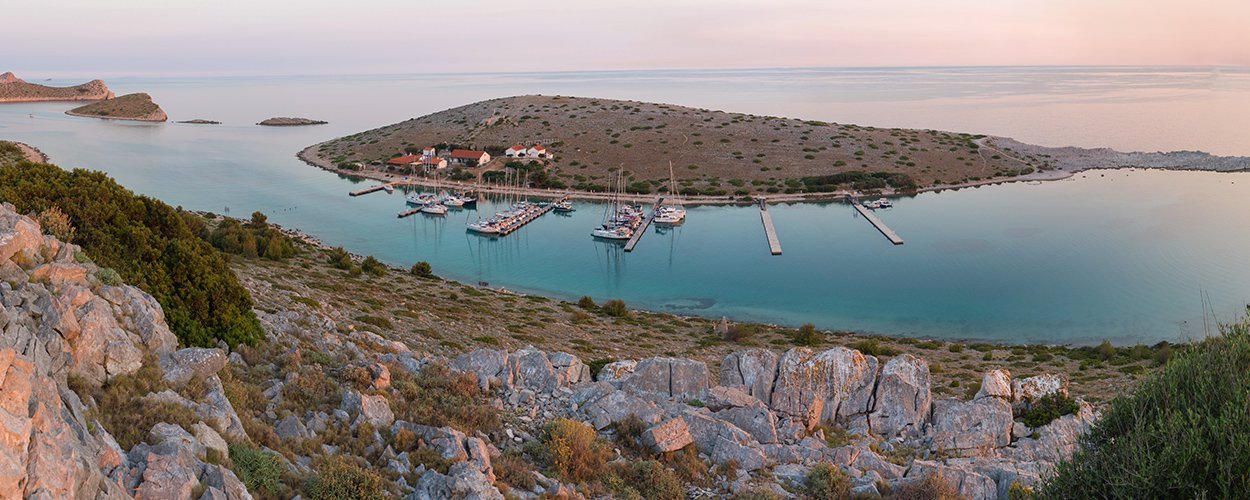
First of all we want to make it clear, that in Croatia, there are marinas, ACI Marinas chain and other privately owned (Marina Vlaska Milna island Brac, and Marina Maslinica island Solta being some of them privately owned or managed) and there are also local ports (city, town and village ports). All of them have slightly different prices and different price policies concerning different seasons in a year etc... All the local ports are managed by different county port authorities (counties are local government units), so there are different prices and price policies in different sailing areas. In some ports, you might also pay extra for water and/or electricity, and additionally for garbage.
Some County Port Authorities are Mali Losinj, Sibenik, and Zadar and Split Dalmatian Port Authority.
All these ports in general, calculate the price by the length of the boat (in meters) and for catamarans and trimarans, they multiply the price for a monohull by at least 1.5. (From this year in ACI and some other marinas, in the high season, a period from 1st July to 31st August, the price for catamarans will be multiplied by 2).
Regarding the prices, we can say that prices in Split-Dalmatian County and Sibenik County are pretty much the same. More north, in Zadar County and Losinj County prices, are from 10-20% more economic.
Now, in this article, we will take a closer look at local ports, which belong under Split-Dalmatian County Port Authority and this is the managing government body which divides its ports into 3 categories:
*Hvar town city port although listed and treated as a port of category 1, has slightly different prices than other ports of Split-Dalmatian County Port Authority of category 1
These ports tend to charge water, electricity and garbage fee separately and add to the price of the berth on the dock itself. (Further down this article we will go into details on the exact way each port on the imaginary route charges extra for electricity, water, and garbage.
Split-Dalmatian County’s Port Authority is not included in the VAT system, so on the part of the invoice you receive for the docking fee VAT is not included and you as a nautical guest do not pay VAT on that part of the invoice. On the other part of the invoice, and that is the one which serves to cover electricity, water and garbage VAT of 25% is included in the price.
How does it work in Split-Dalmatian County? In every town with a port there is one private company which has won the concession on a public tender, and this company is always in charge of the marine area under concession. Every one of these companies has to pay additionally to its town for garbage solutions and has to pay separately for electricity and water, so it is their job to charge the guest for it.
As you can see from their official price list, Split-Dalmatian County Port Authority treats the whole year as the same season, so their prices are the same no matter what time of year you visit. Maybe in the future, they will revise their seasonal price policy, but for now, it’s same price whole year.
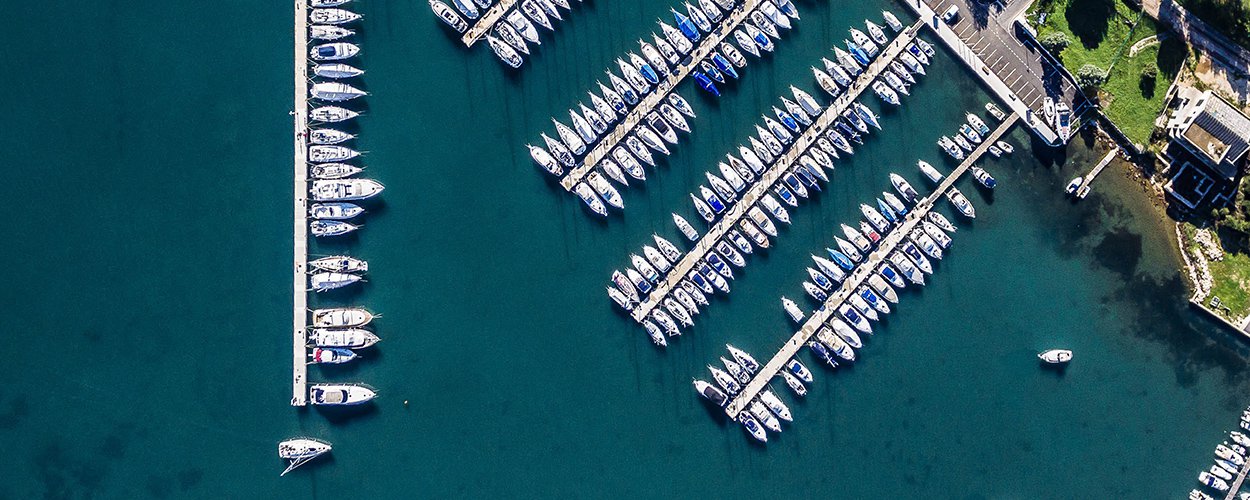
To conclude, let's just say that it is very complicated to answer the question, and the cost will depend on:
Of course, the cost will also depend on the weather, because the worse the weather is, you will spend more time on the dock.
The overall price of port fees for one sailing charter week will also depend on your preferences because some people like to spend as much time on the boat as they can, while others seek comfort and like to dock and explore the island towns and villages in a simple and comfortable way.
Milna town on island Brac is our first destination in the imaginary route, and it’s a great port for the first day, especially if you start from ACI marina Split or Kastela marina. If you start from Trogir (where there are already three big marinas) maybe it’s better to head towards Solta, to Maslinica. This is because Milna is closer to Split and Kastela than Trogir, but not so much, maybe about an hour of sailing difference.
Milna is also great because it is a very safe port, it is a great deep-drawn island gulf, and has plenty of berths for boats of various sizes.
It is protected from all winds.
There are three marinas there, and a local town pier which is usually reserved for ‘trabakuli’ or fishing boats.
Our favorite to dock there is a small private marina Vlaska situated at the very entrance in Milna bay to your port side (left side) when you enter. It’s a ten-minute walk to town, but it is slightly more economical.
Deep down inside the bay, there is ACI marina which is quite nice with shower facilities and a restaurant.
Somewhere in the middle of Milna bay, there is one new private marina, close to the gas station, recently opened, so there are even a few more berths there.
Anchoring is allowed only outside of the Milna bay, as it is rather a narrow bay.
Marina we choose on our most expensive route is ACI marina, as it has plenty of space and it will be more likely to find a place where if you arrive later on Saturday.
Price of port fee in ACI Milna:
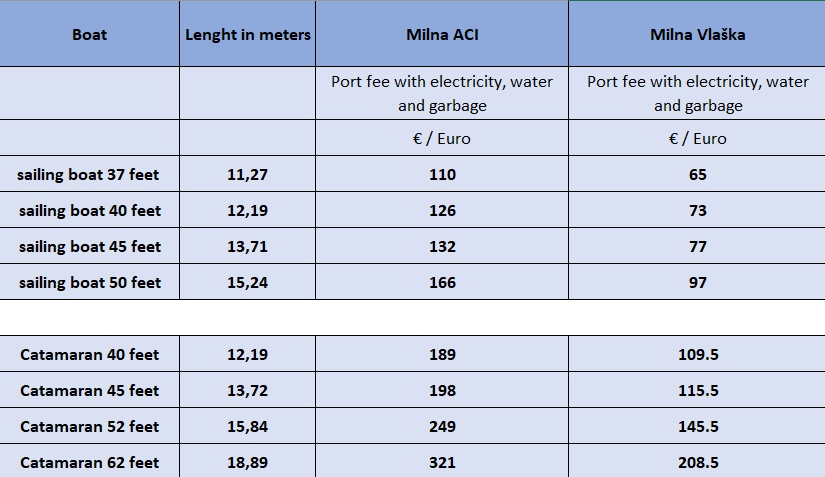
If you are going to Vis town, you should know that island Vis offers plenty of activities and interesting content to explore. In the age of Yugoslavian communism (1945 – 1990), Vis was closed for tourists for 50 years, it had 14 army bases on the island and thus preserved special authenticity.
Geopolitically situated in the middle of the Adriatic Sea, Vis was a strategic point for any power that wanted to rule the Adriatic Sea, so it’s history and way of life is one of a kind. It’s an attraction worth exploring and spending even a day or two on the dock.
There are two sides of the port in Vis town, Luka is the one larger, with about 50 berths on the western side of the bay, and Kut with about 30 berths on the eastern side.
Vis is protected pretty much from all winds, but be careful on the eastern side in Kut area, as well as the eastern part of Luka area when there are NE Bora winds, there might be significant swells in those parts of the port.
There are also buoys (about 50 of them) and some anchoring space (but mostly with depths no less than 20 meters).
In order to make sure you find a docking berth in July & August better be there by 2 PM latest. To get the buoy be there no later than 4 PM. Everything else is a rather a risky game if you don’t have a good anchor and a chain longer than 60 meters. And you know, in case of a storm it can be feisty in Vis port, with many inexperienced fellas anchoring, raising panic and small accidents occurring.
Vis port is under control of Split-Dalmatian County Port Authority, and they charge for port fees in the following way:
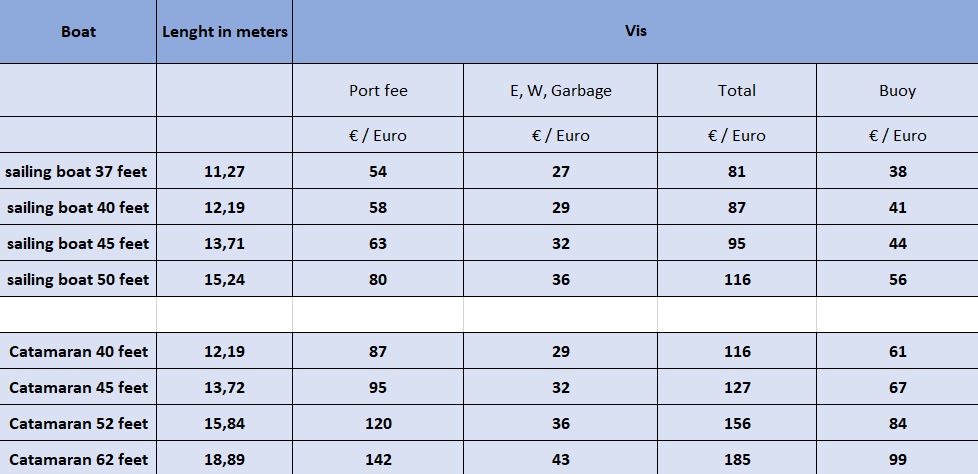
Komiza is a wonderful fishing town, one of such rare jewels in the Mediterranean. It has wonderful pebble beaches all around the town and provides a special relaxing atmosphere. Diving is no.1 there, as is the eventual visit to the Blue Cave on a smaller nearby island Bisevo. However, nowadays in July and August we strongly recommend not to go to the Blue Cave with a boat or a yacht, but, rather take a tour from Komiza. This is because Blue Cave is so popular with tours and tourists coming from Split and Hvar, that is so crowded it is really not a pleasure for anyone. On top of that, if you go there with the boat, you have to catch one of the buoys intended for waiting for your turn to go to the Blue Cave which usually takes a few hours. Those buoys on Bisevo are a disgrace for people who have set them up, and they are skipper’s nightmare because boats keep hitting each other on those buoys.
Komiza has about 30 berths on the main pear and about 40-50 buoys. Anchoring is not recommended because it is quite deep and not well protected. As it’s relatively a small port, in July and August be there no later than noon or 1 PM if you want to dock. If you want a buoy no later than 3 PM. Avoid Komiza port with southern winds or possible storms.
Komiza is also a port under the supervision of Split-Dalmatian County Port Authority, so they charge the port fee according to the same price list as Vis. Of course, they also charge extra for electricity, water, and garbage.
As one of the ports under control of Split-Dalmatian County Port Authority, port fees for catamarans are multiplied by 1.50.
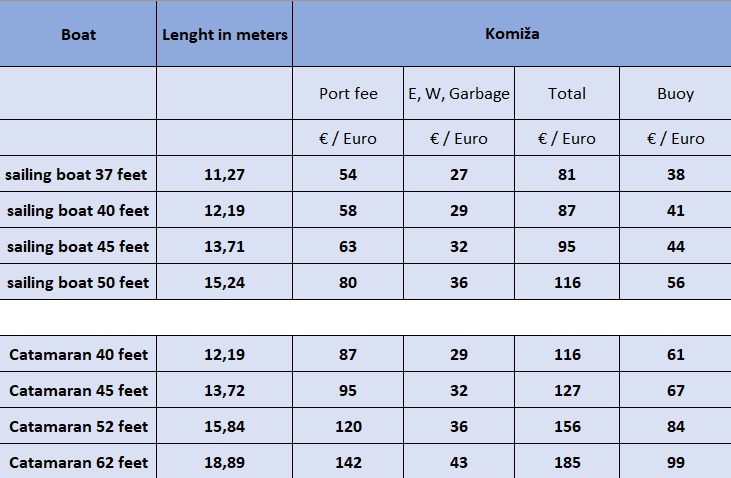
Hvar is a special story, Monte Carlo of Croatia. No need to write about Hvar here, it’s rich history, cafes and restaurant and the bustling nightlife it offers.
We will go more into details about what this town offers for boats, and in which ways you can approach it.
So, the first thing is Hvar town port, which has about 10 or 20 berths on the dock, and about 20 buoys. In July and August city pier is usually reserved for bigger luxury yachts and it is almost impossible to get a place there. If you are lucky try coming about noon, and see if someplace is free, but most of them will be reserved. Port Authority boat will be cruising around the bay, so you can ask them for guidance. The buoys that are there might also be available if you come around noon, or even an hour or two later.
Hvar city port is open to south winds, so avoid it in case of southern winds.
As one of the ports under control of Split-Dalmatian County Port Authority, port fees for catamarans are multiplied by 1.50.
Other ways to see Hvar town are to go to ACI marina Palmizana on Pakleni islands, it is 20 minutes sail from town across the channel to Palmizana ACI marina. Right across from ACI marina on the southern side of the same island there is Vinogradisce bay (which people mistakenly also call Palmizana) with about 40 buoys. From both of these places, you can take a taxi boat to town. Price for the taxi boat is about 15 € per person both ways (if you come back until 2 AM). If you want to stay out late and party it will be more than that. If you don’t want to go to town, you don’t have to. You can enjoy Palmizana bay and the island, walk around, swim, sunbath, and visit some nice restaurants.
Considering the fact it’s July and August you will hardly get a place in the port, but, you can try.
As a most expensive option, we choose docking berth in ACI marina Palmizana, as it is the safest option and protected from all winds.
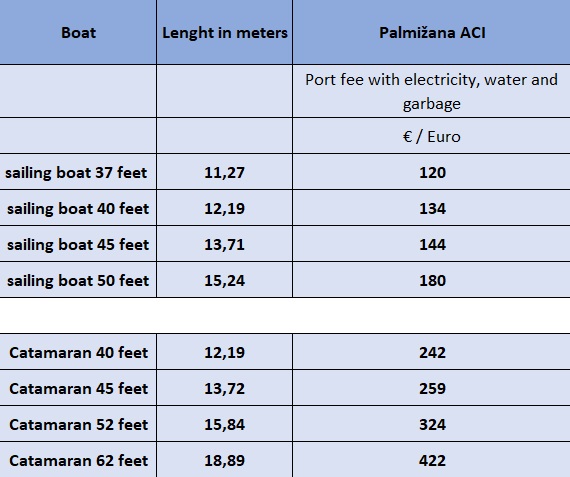
Visiting Hvar town is also possible if you decide to spend the night in Vinogradisce bay, which is situated just a 5-minute walk on the other side of the island of marina Palmizana. It’s a beautiful bay with 4 or 5 good restaurants and a beach bar. Two years ago Vinogradisce bay became buoy anchorage. Since then they charge 7 € per boat meter. Price is the same for catamarans, they don’t charge extra.
Price of 7 € is valid in high season from 1st June to 1st September, and outside of that period is 5 € per meter.
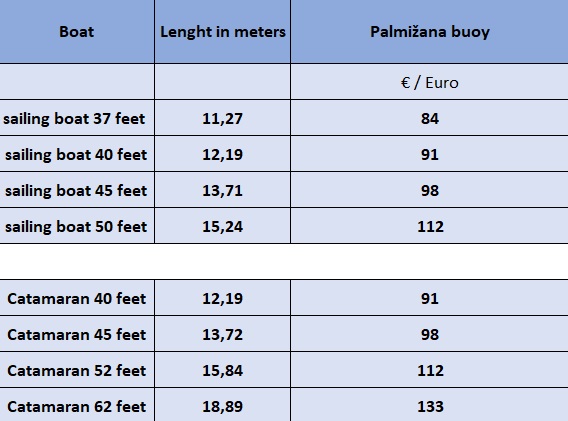
Starigrad is the oldest city on island Hvar, its name actually means ‘the old town’ in the Croatian language. It is very peaceful and relaxing, and it has everything to offer as a normal town (except nightlife really). Prices of food in restaurants in Starigrad are double more economic than in Hvar town.
It is a very safe port, probably the safest port in Central Dalmatia, protected from all winds and it has plenty of docking berths (about 100) and some buoys (about 10).
However, be careful, if you want a place in Starigrad during July or August, be there no later than 2 PM, especially in case bad weather is coming.
Starigrad port is under control of Split-Dalmatian County Port Authority, and they calculate their prices according to Split Dalmatian Port Authority’s price list. So, it is the same as in Vis and Komiza, but in Starigrad they calculate their electricity, water, and garbage in a different way.
To be more precise, in Starigrad, they will calculate electricity by 0.40 € multiplied by meters of the boat, for boats from 10 to 15 meters of length. For boats from 15 to 20 meters they will multiply the length by 0.53 €, for the boat from 20 to 30 meters they will multiply by 0.66 € and so on and they will do the same thing for electricity separately, prices are the same…
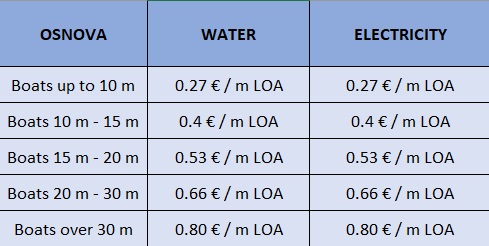
additionally, every boat will pay 3.98 €, fixed amount per boat for garbage.
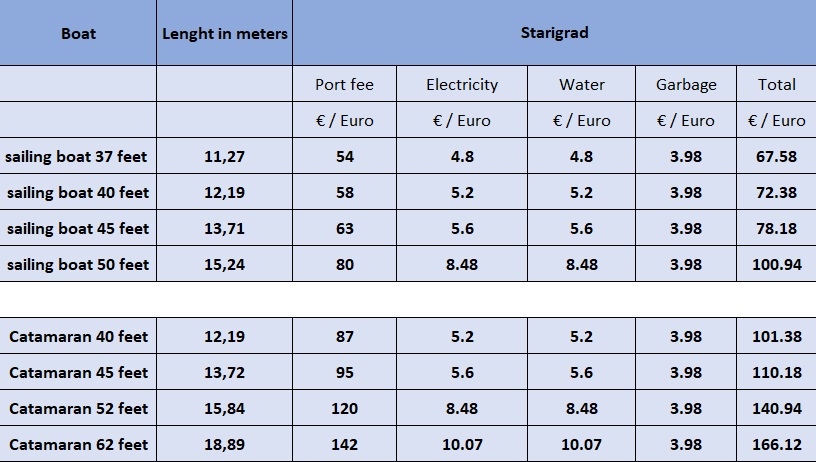
Maslinica marina Martinis Marchi is one of the nicest small marinas in the Mediterranean, if not the world. It’s a private marina and it is actually a part of Martinis Marchi Heritage Hotel & Restaurant resort.
Maslinica town itself is a small Mediterranean village, with a cozy and relaxing atmosphere, with beaches and clear sea at your palm. There are a couple of good restaurants there. It’s a great port for the first or the last day of your trip, and because of its vicinity to starting ports on the mainland, it will be hard to get a place there on Saturdays or Thursdays. But, if you call the marina a day or two in advance you can reserve your spot here. You can find more info and contacts here.
We choose marina Maslinica to be our destination on THE MOST EXPENSIVE HYPOTHETICAL ROUTE because it’s beautiful and definitely deserves to be included here.
Prices in marina Maslinica:
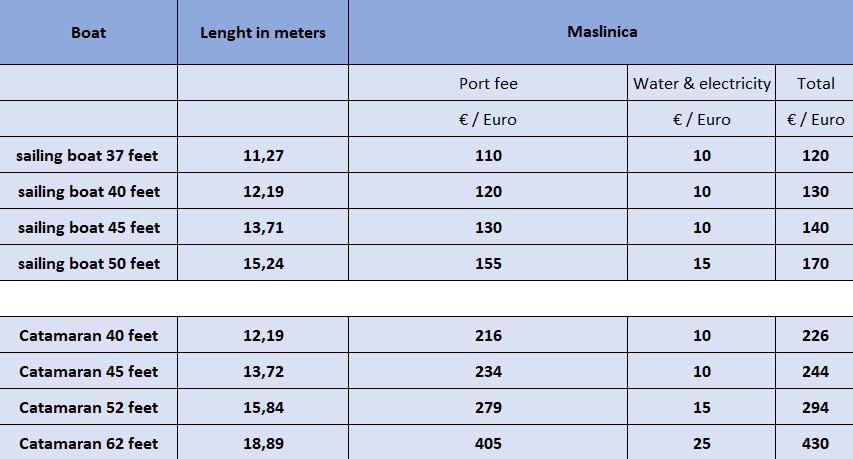
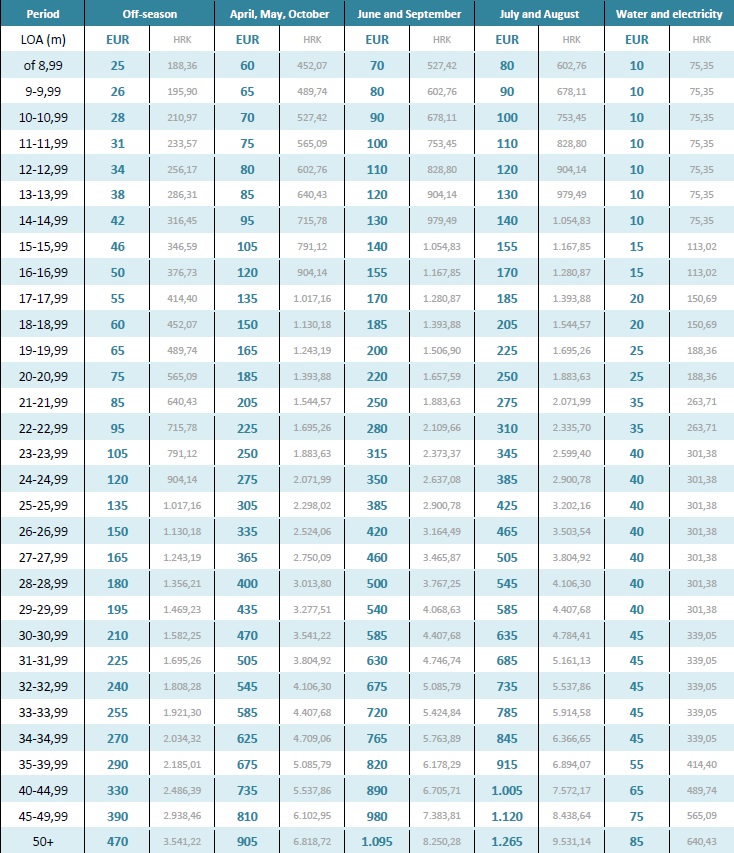

So, the realistic sailing route in Central Dalmatia which is the most popular and most expensive sailing area will visit the same places and destinations as the ‘Hypothetical most expensive route’, but in a realistic and standard way with 3 nights docked, 2 on the buoy and one night on anchor.
For the realistic sailing route, we chose to dock in marina Vlaska in Milna on Brac, Vis town and Starigrad on Hvar island. We chose buoy in Komiza and Palmizana bay Vinogradisce near Hvar town and one night on anchor somewhere in front of Maslinica town on island Solta for example.
